
Boost Your Mobility With PNF Stretching!
PNF stretching is an extremely effective, time-efficient way to implement mobility training after your workouts. We'll show you how to do it!
You can't spend too much time trolling fitness websites without coming across the word "mobility." Want to squat better? Mobilize. Want to learn how to do cleans? Mobilize. Want to feel less sore after a workout? Foam roll and then mobilize.
We agree that mobility and your muscles' range of motion are important factors in fitness. If you want to do an exercise correctly, chances are you're going to want your muscles and joints to move through the motion as smoothly and easily as possible.
The trouble is that, for most of us, stretching is painful and boring. You know you're supposed to stretch after you work out, so you sit on your butt, touch your toes a few times, and maybe do some arm circles. "Is this even doing anything?" you wonder. "Eh, that's probably good. Time to eat."
We've been there, too.
The answer to your problems may be proprioceptive neuromuscular facilitation (PNF) stretching. PNF stretching, also called "active assisted stretching" has been found to better increase range of motion (ROM) than ballistic and static stretching.1-3 Although utilizing PNF stretching can't help you feel motivated to mobilize, it can help you make sure that what you're doing is time efficient and actually working.
WTF Is PNF?
PNF stretching is always done in the same pattern: 10-second stretch, 6-second contraction, 30-second stretch. The first stretch should be just to the point of discomfort. The 6-second contraction is an active isometric contraction at submaximal effort (around 20-50 percent of your max effort) against a partner's or other implement's resistance. The final 30-second passive stretch should go beyond the range of your first stretch. This style of PNF is called "contract-relax."
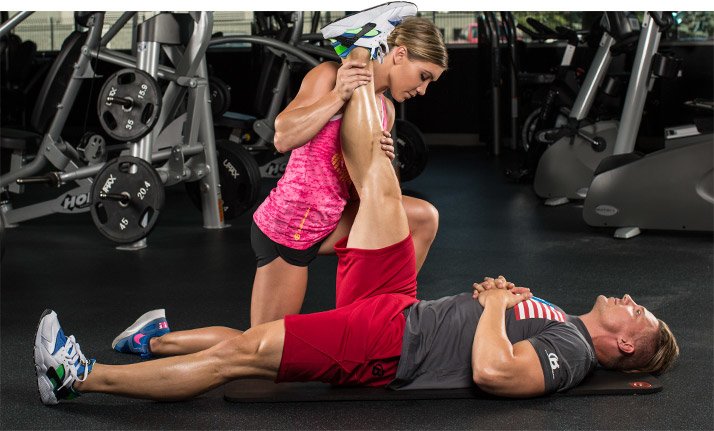
Still a little unclear? We'll use a partner hamstring stretch as the real-world example:
-
Lie on your back with your legs and arms on the floor. Lift one leg and allow your partner to push against it until you feel slight discomfort in your hamstring, and stay in this position for 10 seconds.
-
Next, push with your hamstrings against your partner's resistance for 6 seconds. Think about driving your heel towards the ground.
Follow that contraction by relaxing into a passive stretch by your partner for 30 seconds. After the contraction, you should be able to move your muscle into a greater ROM during the passive stretch.
This basic pattern can be implemented by pretty much anyone. However, there are a few variations you can use depending on your flexibility and comfort level:
For the first variation, begin your PNF stretch just like you normally do by having your partner stretch your hamstring for 10 seconds. Then, instead of isometrically contracting against your partner, have him or her push against you just hard enough that you can contract and move your leg all the way down to the floor against their resistance. After you've moved your muscle through its entire ROM, you'll move into another 30-second passive stretch.
The second variation, referred to as "contract relax agonist contract" (CRAC), calls for you to contract the opposing muscle of the target muscle, or the muscle being stretched. You'll go through the 10-second passive stretch and the 6-second contraction like usual. But as your partner begins pushing your leg into the 30-second stretch, you'll contract your quads to pull the hamstrings into a greater stretch.
Contracting the opposing muscle as the target muscle stretches can actually help increase that muscle's ROM, so you can get even more bang for your buck with this dual focus.
How PNF Works
Your muscles communicate with your nervous system by relaying messages from both sensory and motor neurons. Sensory neurons send sensory information—sight, sound, feeling, and more—to the brain or spinal cord.
Motor neurons, on the other hand, are responsible for stimulating a muscle contraction. When the communication between a motor neuron and muscle is reduced, the muscle relaxes. One of the ways this happens is through activation of golgi tendon organs.
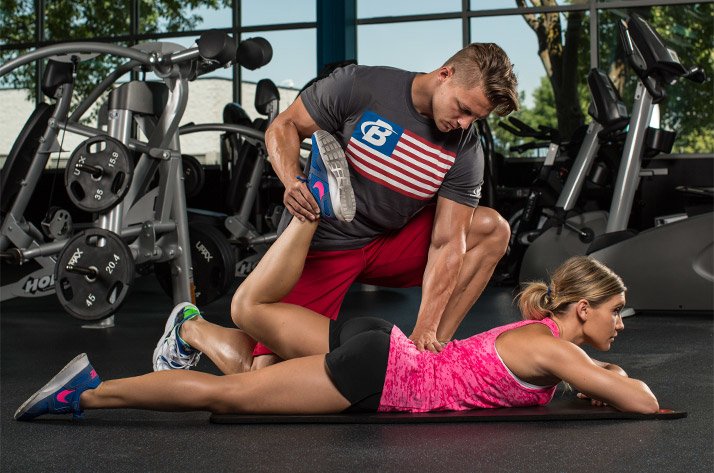
Golgi tendon organs (GTOs) are sensory receptors located within muscle tendons. GTOs respond to changes in muscle tension and provide feedback to your brain to regulate muscle force. Think of it as a safety mechanism: When tension in the muscle reaches levels that could pose a potential risk of injury, GTOs are stimulated to cause the muscle to relax.
PNF stretching works because the isometric contraction activates the GTO, ultimately allowing the muscle to lengthen and experience a greater ROM. This technique utilizes "autogenic inhibition," which relaxes a muscle after a sustained contraction is held for 6 seconds. This process allows your muscle to be stretched beyond its initial maximum.1-4
PNF can also work through what's called "reciprocal inhibition," which means one side of a joint relaxes to allow for the contraction of the other. Voluntary contraction of the opposing muscle has been shown to reduce activation levels in the target muscle, allowing it to lengthen and achieve greater gains in ROM.5,6
It's a pretty neat way to use those innate body processes to improve your mobility.
Implementing PNF stretching
Because PNF stretching may challenge your flexibility beyond your usual ability, it's not a good idea to do it when you're cold. The best time to implement PNF stretching is after you've trained, when your muscles are already warm. One full repetition of PNF for each target muscle is enough to increase your ROM.
Start by implementing PNF stretching into your routine twice per week. Because you're challenging your muscles through a larger ROM, they may need a little time to recover before you hit them again, so wait a day or two between bouts of PNF. Whether you use PNF for a few weeks or a year, changes in ROM will occur.
The best way to use PNF stretching is to grab a partner. If you have a training partner, then you already have a PNF stretching partner! After your workout, try some of these PNF stretches:
Partner hamstring stretch
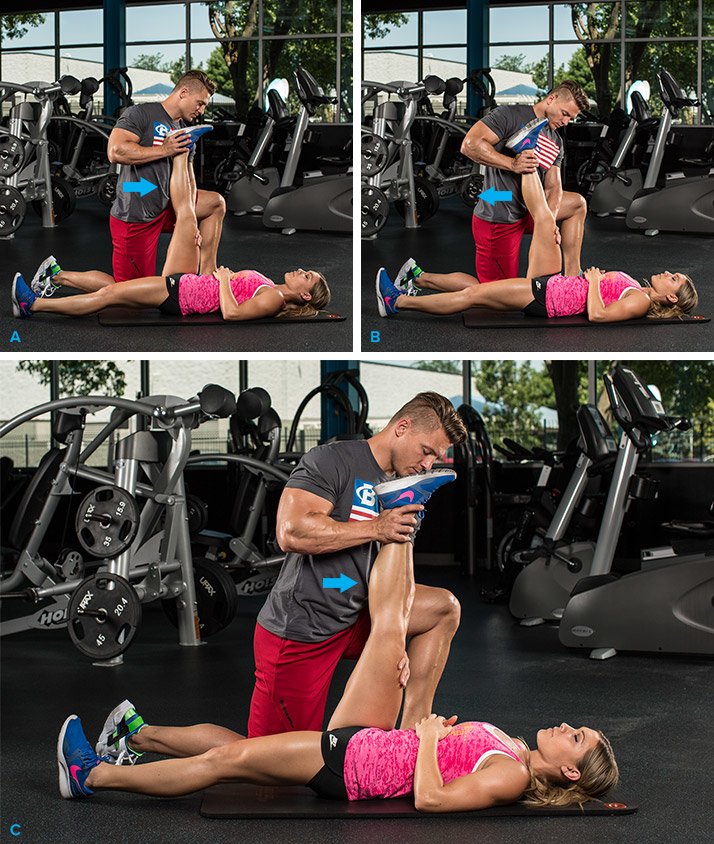
Partner hamstring stretch
- Lie on your back with your arms and legs on the floor. Have your partner pick up your right leg off the floor and push it toward your chest. Keep both legs straight.
- Your partner should push your leg just far enough that you feel slight discomfort. Hold the stretch for 10 seconds.
- After 10 seconds, actively push back against your partner's resistance for 6 seconds.
- When the 6 seconds is up, relax your hamstring and allow your partner to push it farther than on the first stretch. During this period, you can contract your quads for even greater hamstring ROM gains.
- Repeat with the other leg.
Partner chest stretch
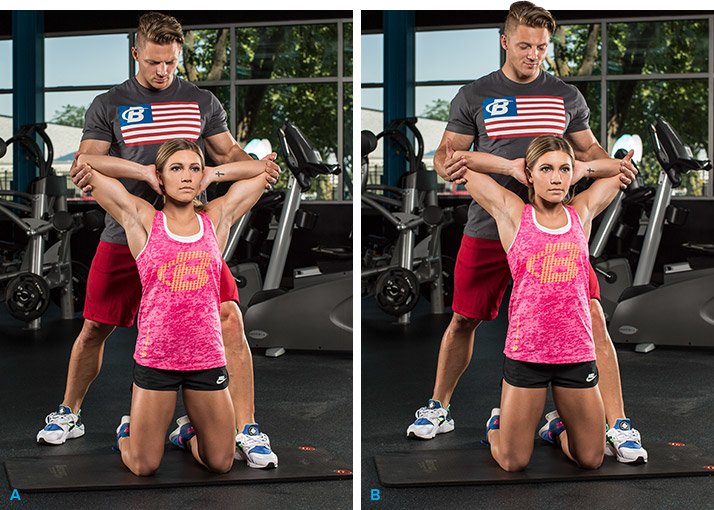
Partner chest stretch
- Sit on the floor with your legs comfortably in front of you. Your chest should be up and your back straight. Put your hands on the back of your head and interlace your fingers.
- Have your partner stand behind you and put his or her hands on the inside of your elbows. Allow them to pull back on your elbows until you feel a stretch in your chest and front delts. Hold for 10 seconds.
- After 10 seconds, try to bring your elbows in toward your midline against your partner's resistance. Hold that contraction for 6 seconds.
- Finish by relaxing and allowing your chest to stretch further for 30 seconds. During this period, you can contract your upper back for even greater pectoral ROM gains.
Partner quad stretch
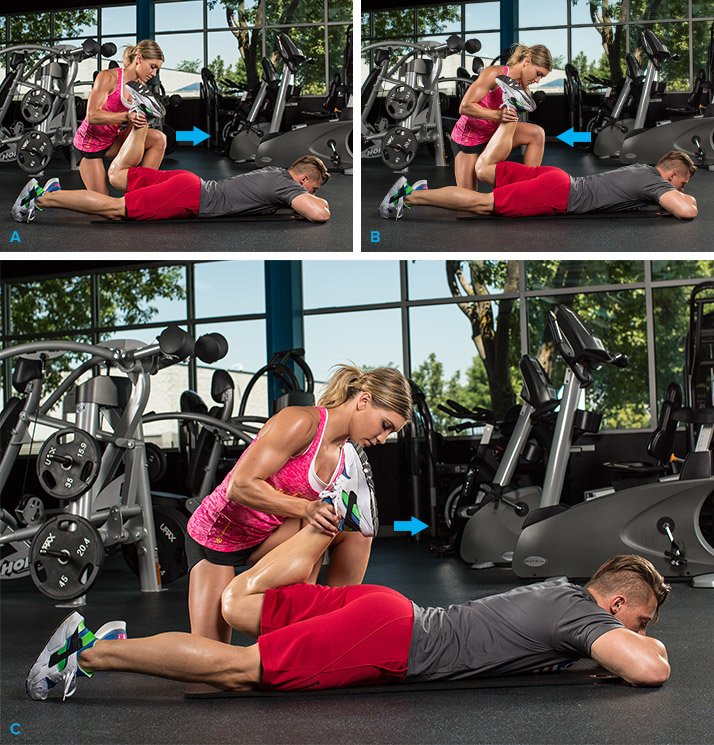
Partner quad stretch
- Lie on your stomach with your legs extended and your arms at your sides.
- Have your partner kneel on your right side and place one hand on your lower back or glutes. His or her other hand should grasp your ankle or knee and push your shin toward your butt. You should feel a stretch in your quadriceps.
- Allow your partner to stretch your quads for 10 seconds.
- After 10 seconds, try to push your foot back toward the ground against your partner's resistance and hold for 6 seconds.
- Following this 6-second contraction, relax and allow your partner to stretch your quads for another 30 seconds. During this period, you can contract your hamstrings for even greater quadriceps ROM gains.
- Repeat with the other leg.
If you train alone and don't have access to a gym buddy, you can still do PNF stretching! Grab a band or towel and try these solo stretches.
Calf self stretch
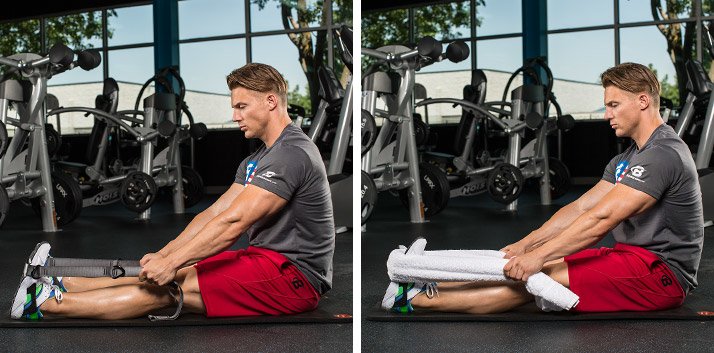
Calf self stretch
- Sit on the floor with your legs extended in front of you. Holding both ends of a towel or band, loop the middle around the pad of your foot.
- Bring your toes toward your shin by pulling on the band or towel. Hold for 10 seconds.
- Keep tension on the band as you press against it for 6 seconds.
- After 6 seconds, relax your calf and let your toes come back toward your shin. Hold for 30 seconds. During this period, you can contract your anterior tibialis (the muscle in front of your shin) for greater calf ROM gains.
- Repeat with the other leg.
Hamstring self stretch
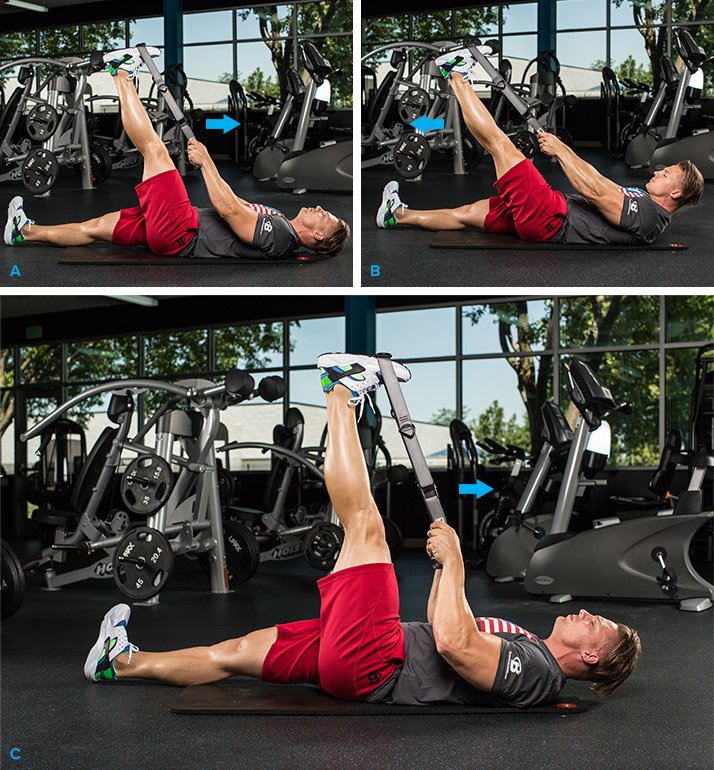
Hamstring self stretch
- Lie on your back with your arms and legs on the floor. Raise your right leg off the floor so the bottom of your foot is facing the ceiling. Holding either end of the towel or band, loop the middle around the pad of your foot. Keep both legs straight.
- Pull your right leg toward your body just far enough that you feel slight discomfort and hold for 10 seconds.
- After 10 seconds, actively push back against the band's resistance for 6 seconds.
- When the 6 seconds is up, relax your hamstring and try to pull your leg farther than you did on the first stretch. During this period, you can contract your quadriceps for even greater hamstring ROM gains.
- Repeat with the other leg.
Piriformis self stretch
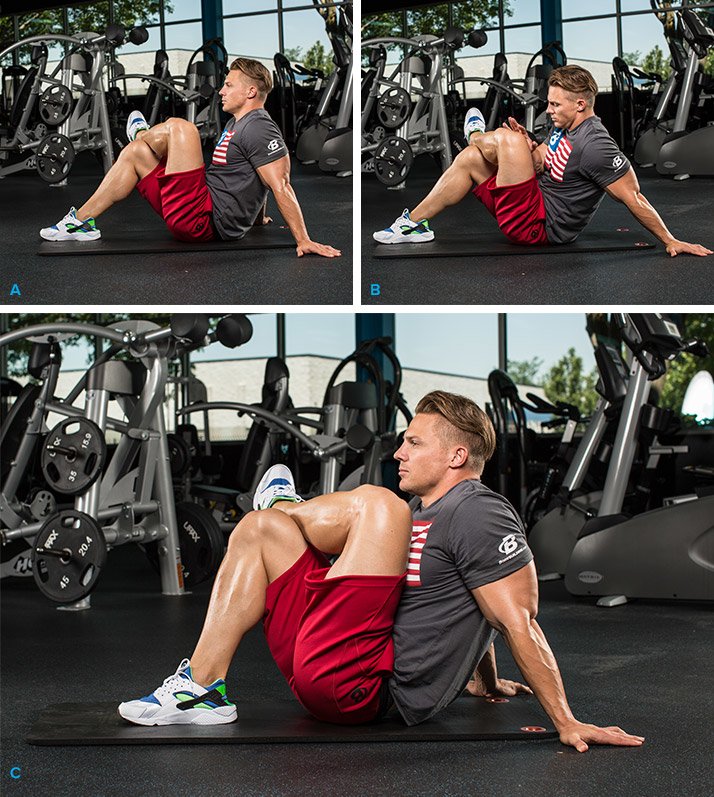
Piriformis self stretch
- Sit on the floor with your left leg bent and your right ankle over your left knee. Your chest should be up and your spine straight. If you need, place your left hand on the floor to help you balance.
- Put your right hand on your right knee and push your knee toward the floor. Hold for 10 seconds.
- After 10 seconds, push your knee up toward the ceiling and into your own resistance. Hold for 6 seconds.
- After 6 seconds, relax your leg and try to push your knee further down than it was during the first stretch.
- Repeat with the other leg.
References
- Etnyre, B. R., & Abraham, L. D. (1986). Gains in range of ankle dorsiflexion using three popular stretching techniques. American Journal of Physical Medicine & Rehabilitation, 65(4), 189-196.
- Wallin, D., Ekblom, B., Grahn, R., & Nordenborg, T. (1985). Improvement of muscle flexibility A comparison between two techniques. The American Journal of Sports Medicine, 13(4), 263-268.
- Sady, S. P., Wortman, M., & Blanke, D. (1982). Flexibility training: ballistic, static or proprioceptive neuromuscular facilitation? Archives of Physical Medicine and Rehabilitation, 63(6), 261-263.
- Prentice, W. E. (1983). A comparison of static stretching and PNF stretching for improving hip joint flexibility. Athletic Training, 18(1), 56-59.
- Osternig, L. R., Robertson, R. N., Troxel, R. K., & Hansen, P. A. U. L. (1990). Differential responses to proprioceptive neuromuscular facilitation (PNF) stretch techniques. Medicine & Science in Sports & Exercise, (22), 106-11.
- Cornelius, W. L., & Hinson, M. M. (1980). The relationship between isometric contractions of hip extensors and subsequent flexibility in males. The Journal of Sports Medicine and Physical Fitness, 20(1), 75-80.
